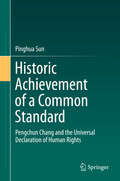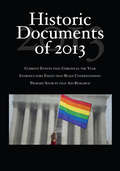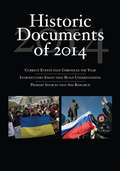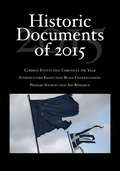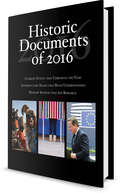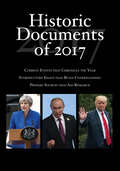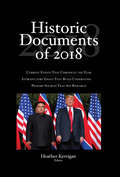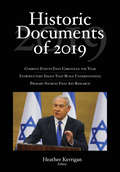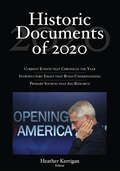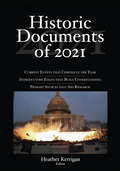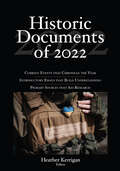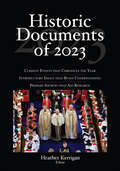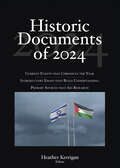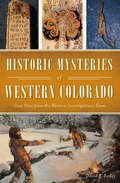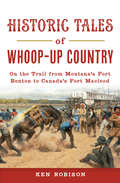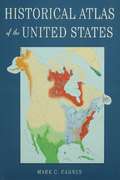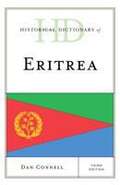- Table View
- List View
Historic Achievement of a Common Standard: Pengchun Chang And The Universal Declaration Of Human Rights
by Pinghua SunThe subject of this book is human rights law, focusing on historic achievement of a common standard viewed from a perspective of Pengchun Chang’s contributions to the drafting of the Universal Declaration of Human Rights (UDHR). This is an original research, integrating different research methods: inter-disciplinary approaches, historical and comparative methods, and documentary research and so on. The research findings can be described briefly as follows: Chinese wisdom has played an important role in achieving a common standard for the establishment of the international human rights system, which can be seen by exploring P. C. Chang’s contributions to the drafting of the UDHR. The target readers are global scholars and students in law, politics, philosophy, international relations, human rights law, legal history, religion and culture. This book will enable these potential readers to have a vivid picture of the Chinese contributions to the international human rights regime and to have a better understanding of the significance of the traditional Chinese culture and P. C. Chang’s human rights philosophy of pluralism.
Historic Documents of 2013
by Cq PressFor more than 40 years the Historic Documents series has made primary source research easy by presenting full primary documents and excerpts from documents on the important events of each year for the United States and the world. Each volume includes approximately 70 events with well over 100 documents from the previous year, from official or other influential reports and surveys, to speeches from leaders and opinion makers, to court cases, legislation, testimony, and much more. Historic Documents is renowned for the well-written and informative background, history, and context it provides for each document. Each volume begins with an insightful essay that sets the year’s events in context, and each document or group of documents is preceded by a comprehensive introduction that provides background information on the event. Full-source citations are provided. Readers have easy access to material through a detailed, thematic table of contents and a cumulative five-year index that directs them to related material in earlier volumes.
Historic Documents of 2014
by Cq Press Heather KerriganFor more than 40 years the Historic Documents series has made primary source research easy by presenting full primary documents and excerpts from documents on the important events of each year for the United States and the world. Each volume includes approximately 70 events with well over 100 documents from the previous year, from official or other influential reports and surveys, to speeches from leaders and opinion makers, to court cases, legislation, testimony, and much more. Historic Documents is renowned for the well-written and informative background, history, and context it provides for each document. Published annually, the updated 2014 volume begins with an insightful essay that sets the year’s events in context, and each document or group of documents is preceded by a comprehensive introduction that provides background information on the event. Full-source citations are provided. Readers have easy access to material through a detailed, thematic table of contents and an index, as well as an“Other Historic Documents of Interest” section which lists related entries from this and previous editions.
Historic Documents of 2015
by Heather KerriganFor more than 40 years, the Historic Documents series has made primary source research easy by presenting excerpts from documents on the important events of each year for the United States and the World. Each volume includes 60 to 70 events with well over 100 documents from the previous year, from official reports and surveys to speeches from leaders and opinion makers, to court cases, legislation, testimony, and much more. Historic Documents is renowned for the well-written and informative background, history, and context it provides for each document. Each volume begins with an insightful essay that sets the year’s events in context, and each document or group of documents is preceded by a comprehensive introduction that provides background information on the event. Full-source citations are provided. Readers have easy access to material through a detailed, thematic table of contents, and each event includes references to related coverage and documents from the last ten editions of the series.
Historic Documents of 2016
by Heather KerriganPublished annually since 1972, the Historic Documents series has made primary source research easy by presenting excerpts from documents on the important events of each year for the United States and the World. Each volume pairs 60 to 70 original background narratives with well over 100 documents to chronicle the major events of the year, from official reports and surveys to speeches from leaders and opinion makers, to court cases, legislation, testimony, and much more. Historic Documents is renowned for the well-written and informative background, history, and context it provides for each document. Organized chronologically, each volume covers the same wide range of topics: business, the economy and labor; energy, environment, science, technology, and transportation; government and politics; health and social services; international affairs; national security and terrorism; and rights and justice. Each volume begins with an insightful essay that sets the year’s events in context, and each document or group of documents is preceded by a comprehensive introduction that provides background information on the event. Full-source citations are provided. Readers have easy access to material through a detailed, thematic table of contents, and each event includes references to related coverage and documents from the last ten editions of the series.
Historic Documents of 2017
by Heather KerriganFor more than 45 years, the Historic Documents series has made primary source research easy by presenting excerpts from documents on the important events of each year for the United States and the world. Each volume includes approximately 60 events with well over 100 documents from the previous year, from official or other influential reports and surveys, to speeches from leaders and opinion makers, to court cases, legislation, testimony, and much more. Historic Documents is renowned for the well-written and informative background, history, and context it provides for each document. Each volume begins with an insightful essay that sets the year’s events in context, and each document or group of documents is preceded by a comprehensive introduction that provides background information on the event. Full-source citations are provided. Readers have easy access to material through a detailed, thematic table of contents, and each event includes references to related coverage and documents from the last ten editions of the series. Events covered in the 2017 Edition include: The intricacies of the new presidential administration of Donald Trump Russian involvement in the U.S. presidential election U.S. and global policies on immigration and refugees Landmark Supreme Court rulings on gerrymandering and state grant money for parochial schools, and the appointment of Neil Gorsuch Global warming and climate change agreements and policies European elections, including those in the UK, France, and Germany Outcomes of the G-20 Summit North Korea and international calls to action Volumes in this series dating back to 1972 are available as online editions on SAGE Knowledge.
Historic Documents of 2018
by Heather KerriganPublished annually since 1972, the Historic Documents series has made primary source research easy by presenting excerpts from documents on the important events of each year for the United States and the World. Each volume pairs original background narratives with well over 100 documents to chronicle the major events of the year, from official reports and surveys to speeches from leaders and opinion makers, to court cases, legislation, testimony, and much more. Historic Documents is renowned for the well-written and informative background, history, and context it provides for each document. Each volume begins with an insightful essay that sets the year’s events in context, and each document or group of documents is preceded by a comprehensive introduction that provides background information on the event. Full-source citations are provided. Readers have easy access to material through a detailed, thematic table of contents, and each event includes references to related coverage and documents from the last ten editions of the series. Events covered in the 2018 Edition include: Historic U.S. and South Korean diplomatic advances with North Korea Investigation of Russian influence in U.S. elections Chinese constitutional changes granting presidential terms for life March for Our Lives and gun control demonstrations Changes to U.S. immigration and trade policies Legalization of marijuana in Canada Resignation of Australian prime minister Pope declares death penalty inadmissible Volumes in this series dating back to 1972 are available as online editions on SAGE Knowledge.
Historic Documents of 2018
by Heather KerriganPublished annually since 1972, the Historic Documents series has made primary source research easy by presenting excerpts from documents on the important events of each year for the United States and the World. Each volume pairs original background narratives with well over 100 documents to chronicle the major events of the year, from official reports and surveys to speeches from leaders and opinion makers, to court cases, legislation, testimony, and much more. Historic Documents is renowned for the well-written and informative background, history, and context it provides for each document. Each volume begins with an insightful essay that sets the year’s events in context, and each document or group of documents is preceded by a comprehensive introduction that provides background information on the event. Full-source citations are provided. Readers have easy access to material through a detailed, thematic table of contents, and each event includes references to related coverage and documents from the last ten editions of the series. Events covered in the 2018 Edition include: Historic U.S. and South Korean diplomatic advances with North Korea Investigation of Russian influence in U.S. elections Chinese constitutional changes granting presidential terms for life March for Our Lives and gun control demonstrations Changes to U.S. immigration and trade policies Legalization of marijuana in Canada Resignation of Australian prime minister Pope declares death penalty inadmissible Volumes in this series dating back to 1972 are available as online editions on SAGE Knowledge.
Historic Documents of 2019 (Historic Documents)
by Heather KerriganPublished annually since 1972, the Historic Documents series has made primary source research easy by presenting excerpts from documents on the important events of each year for the United States and the World. Each volume pairs 60 to 70 original background narratives with over 100 documents to chronicle the major events. Various records may include: • official reports • surveys • speeches from leaders and opinion makers • court cases • legislation • testimony • and much more Historic Documents is renowned for the well-written and informative background, history, and context it provides for each document. Organized chronologically, each volume covers the same wide range of topics: • business • the economy and labor • energy, environment, science, technology, and transportation • government and politics • health and social services • international affairs • national security and terrorism • rights and justice Each volume begins with an insightful essay that sets the year&’s events in context, and each document or group of documents include: • a comprehensive introduction • background information on the event • full-source citations • easy access to material • detailed and thematic table of contents • references to related coverage • documents from the last ten editions of the series
Historic Documents of 2019 (Historic Documents)
by Heather KerriganPublished annually since 1972, the Historic Documents series has made primary source research easy by presenting excerpts from documents on the important events of each year for the United States and the World. Each volume pairs 60 to 70 original background narratives with over 100 documents to chronicle the major events. Various records may include: • official reports • surveys • speeches from leaders and opinion makers • court cases • legislation • testimony • and much more Historic Documents is renowned for the well-written and informative background, history, and context it provides for each document. Organized chronologically, each volume covers the same wide range of topics: • business • the economy and labor • energy, environment, science, technology, and transportation • government and politics • health and social services • international affairs • national security and terrorism • rights and justice Each volume begins with an insightful essay that sets the year&’s events in context, and each document or group of documents include: • a comprehensive introduction • background information on the event • full-source citations • easy access to material • detailed and thematic table of contents • references to related coverage • documents from the last ten editions of the series
Historic Documents of 2020 (Historic Documents)
by Heather KerriganPublished annually since 1972, the Historic Documents series has made primary source research easy by presenting excerpts from documents on the important events of each year for the United States and the World. Each volume pairs 60 to 70 original background narratives with well over 100 documents to chronicle the major events of the year, from official reports and surveys to speeches from leaders and opinion makers, to court cases, legislation, testimony, and much more. Historic Documents is renowned for the well-written and informative background, history, and context it provides for each document. Organized chronologically, each volume covers the same wide range of topics: business, the economy and labor; energy, environment, science, technology, and transportation; government and politics; health and social services; international affairs; national security and terrorism; and rights and justice. Each volume begins with an insightful essay that sets the year’s events in context, and each document or group of documents is preceded by a comprehensive introduction that provides background information on the event. Full-source citations are provided. Readers have easy access to material through a detailed, thematic table of contents, and each event includes references to related coverage and documents from the last ten editions of the series.
Historic Documents of 2020 (Historic Documents)
by Heather KerriganPublished annually since 1972, the Historic Documents series has made primary source research easy by presenting excerpts from documents on the important events of each year for the United States and the World. Each volume pairs 60 to 70 original background narratives with well over 100 documents to chronicle the major events of the year, from official reports and surveys to speeches from leaders and opinion makers, to court cases, legislation, testimony, and much more. Historic Documents is renowned for the well-written and informative background, history, and context it provides for each document. Organized chronologically, each volume covers the same wide range of topics: business, the economy and labor; energy, environment, science, technology, and transportation; government and politics; health and social services; international affairs; national security and terrorism; and rights and justice. Each volume begins with an insightful essay that sets the year’s events in context, and each document or group of documents is preceded by a comprehensive introduction that provides background information on the event. Full-source citations are provided. Readers have easy access to material through a detailed, thematic table of contents, and each event includes references to related coverage and documents from the last ten editions of the series.
Historic Documents of 2021 (Historic Documents)
by Heather Kerrigan River Horse Communications, LLCThe Historic Documents of 2021 makes primary source research easy by presenting excerpts from documents on the important events of the United States and the World. The Historic Documents of 2021 pairs 60 to 70 original background narratives with well over 100 documents to chronicle the major events of the year, from official reports and surveys to speeches from leaders and opinion makers, to court cases, legislation, testimony, and much more. Historic Documents is renowned for the well-written and informative background, history, and context it provides for each document. Organized chronologically, it covers the same wide range of topics: business, the economy and labor; energy, environment, science, technology, and transportation; government and politics; health and social services; international affairs; national security and terrorism; and rights and justice.
Historic Documents of 2021 (Historic Documents)
by Heather Kerrigan River Horse Communications, LLCThe Historic Documents of 2021 makes primary source research easy by presenting excerpts from documents on the important events of the United States and the World. The Historic Documents of 2021 pairs 60 to 70 original background narratives with well over 100 documents to chronicle the major events of the year, from official reports and surveys to speeches from leaders and opinion makers, to court cases, legislation, testimony, and much more. Historic Documents is renowned for the well-written and informative background, history, and context it provides for each document. Organized chronologically, it covers the same wide range of topics: business, the economy and labor; energy, environment, science, technology, and transportation; government and politics; health and social services; international affairs; national security and terrorism; and rights and justice.
Historic Documents of 2022 (Historic Documents)
by Heather Kerrigan River Horse Communications, LLCPublished annually since 1972, the Historic Documents series has made primary source research easy by presenting excerpts from documents on the important events of each year for the United States and the World. Each volume pairs 60 to 70 original background narratives with well over 100 documents to chronicle the major events of the year, from official reports and surveys to speeches from leaders and opinion makers, to court cases, legislation, testimony, and much more.
Historic Documents of 2022 (Historic Documents)
by Heather KerriganPublished annually since 1972, the Historic Documents series has made primary source research easy by presenting excerpts from documents on the important events of each year for the United States and the World. Each volume pairs 60 to 70 original background narratives with well over 100 documents to chronicle the major events of the year, from official reports and surveys to speeches from leaders and opinion makers, to court cases, legislation, testimony, and much more.
Historic Documents of 2023
by Heather KerriganPublished annually since 1972, the Historic Documents series has made primary source research easy by presenting excerpts from documents on the important events of each year for the United States and the World. Each volume pairs 60 to 70 original background narratives with well over 100 documents to chronicle the major events of the year, from official reports and surveys to speeches from leaders and opinion makers, to court cases, legislation, testimony, and much more. Historic Documents is renowned for the well-written and informative background, history, and context it provides for each document. Organised chronologically, each volume covers the same wide range of topics: business, the economy and labor; energy, environment, science, technology, and transportation; government and politics; health and social services; international affairs; national security and terrorism; and rights and justice. Each volume begins with an insightful essay that sets the year’s events in context, and each document or group of documents is preceded by a comprehensive introduction that provides background information on the event. Full-source citations are provided. Readers have easy access to material through a detailed, thematic table of contents, and each event includes references to related coverage and documents from the last ten editions of the series.
Historic Documents of 2023
by Heather Kerrigan River Horse Communications, LLPPublished annually since 1972, the Historic Documents series has made primary source research easy by presenting excerpts from documents on the important events of each year for the United States and the World. Each volume pairs 60 to 70 original background narratives with well over 100 documents to chronicle the major events of the year, from official reports and surveys to speeches from leaders and opinion makers, to court cases, legislation, testimony, and much more. Historic Documents is renowned for the well-written and informative background, history, and context it provides for each document. Organised chronologically, each volume covers the same wide range of topics: business, the economy and labor; energy, environment, science, technology, and transportation; government and politics; health and social services; international affairs; national security and terrorism; and rights and justice. Each volume begins with an insightful essay that sets the year’s events in context, and each document or group of documents is preceded by a comprehensive introduction that provides background information on the event. Full-source citations are provided. Readers have easy access to material through a detailed, thematic table of contents, and each event includes references to related coverage and documents from the last ten editions of the series.
Historic Documents of 2024 (Historic Documents)
by Heather KerriganPublished annually since 1972, Historic Documents provides an unparalleled collection of primary sources that chronicle the most significant events of each year in the United States and around the world. Each edition features 60 to 70 original background narratives and more than 100 primary source documents—including official reports, speeches, legislation, court decisions, testimony, and more. Known for its exceptional editorial quality, the series offers expertly written context for each document, making primary source research accessible and meaningful. Organized chronologically, the volume covers key developments across a wide range of areas including politics, the economy, labor, international affairs, rights and justice, health, science, environment, and national security. A comprehensive introductory essay situates the year’s events, while full-source citations, a detailed thematic table of contents, and cross-references to the past decade of volumes enhance usability for researchers, educators, and students alike.
Historic Documents of 2024 (Historic Documents)
by Heather KerriganPublished annually since 1972, Historic Documents provides an unparalleled collection of primary sources that chronicle the most significant events of each year in the United States and around the world. Each edition features 60 to 70 original background narratives and more than 100 primary source documents—including official reports, speeches, legislation, court decisions, testimony, and more. Known for its exceptional editorial quality, the series offers expertly written context for each document, making primary source research accessible and meaningful. Organized chronologically, the volume covers key developments across a wide range of areas including politics, the economy, labor, international affairs, rights and justice, health, science, environment, and national security. A comprehensive introductory essay situates the year’s events, while full-source citations, a detailed thematic table of contents, and cross-references to the past decade of volumes enhance usability for researchers, educators, and students alike.
Historic Mysteries of Western Colorado: Case Files from the Western Investigations Team (American Chronicles)
by David P BaileyFrom Mesoamerican mysteries to local legends, history waits to be unearthed on Colorado’s western slope . . .A crew of historians, archaeologists, and scientists, the Western Investigations Team uses ground-penetrating radar, electron microscopy, innovative metallurgic research, and newly discovered documents to re-examine fascinating historical questions and contribute new chapters to history.This book offers stories of their fascinating work, accompanied by many photos. Revelations include discovering new evidence in the infamous case of Alferd Packer, aka the “Colorado Cannibal,” and old Spanish colonial relics near Kannah Creek. Investigators follow the trail of lost Spanish explorers searching for the Seven Cities of Gold, and pursue archaeological signs of a prehistoric civilization north of Collbran. Expeditions search for the legend of the Utes’ Cave of the Ancients and the fabled location of Aztlán, the Aztecs’ original homeland. These and other tales offer an intriguing new look at the history of western Colorado.
Historic Tales of Whoop-Up Country: On the Trail from Montana's Fort Benton to Canada's Fort Macleod (Lost)
by Ken RobisonWithdrawal of the mighty Hudson Bay Company from present-day Alberta and Saskatchewan created a lawless environment with new economic opportunities. A cross-border trading bond arose with growing steamboat mercantile center Fort Benton in Montana Territory. In 1870, Montana traders Johnny Healy and Al Hamilton moved across the Medicine Line and built Fort Whoop-Up. It established the two-hundred-mile Whoop-Up Trail from Fort Benton, through Blackfoot lands, to the Belly River near today's Lethbridge. Over the next decade, the buffalo robe trade flourished with the Blackfoot, as did violence. The turmoil forced the creation of Canada's North West Mounted Police, tasked with closing down the whiskey trade and evicting the Montana traders. Award-winning historian Ken Robison brings to life this dramatic story.
Historical Atlas of Northeast Asia, 1590-2010: Korea, Manchuria, Mongolia, Eastern Siberia
by Robert Cribb Narangoa LiFour hundred years ago, indigenous peoples occupied the vast region that today encompasses Korea, Manchuria, the Mongolian Plateau, and Eastern Siberia. Over time, these populations struggled to maintain autonomy as Russia, China, and Japan sought hegemony over the region. Especially from the turn of the twentieth century onward, indigenous peoples pursued self-determination in a number of ways, and new states, many of them now largely forgotten, rose and fell as great power imperialism, indigenous nationalism, and modern ideologies competed for dominance.This atlas tracks the political configuration of Northeast Asia in ten-year segments from 1590 to 1890, in five-year segments from 1890 to 1960, and in ten-year segments from 1960 to 2010, delineating the distinct history and importance of the region. The text follows the rise and fall of the Qing dynasty in China, founded by the semi-nomadic Manchus; the Russian colonization of Siberia; the growth of Japanese influence; the movements of peoples, armies, and borders; and political, social, and economic developments—reflecting the turbulence of the land that was once the world's "cradle of conflict." Compiled from detailed research in English, Chinese, Japanese, French, Dutch, German, Mongolian, and Russian sources, the Historical Atlas of Northeast Asia incorporates information made public with the fall of the Soviet Union and includes fifty-five specially drawn maps, as well as twenty historical maps contrasting local and outsider perspectives. Four introductory maps survey the region's diverse topography, climate, vegetation, and ethnicity.
Historical Atlas of the United States
by Mark C. CarnesDesigned for all libraries, this large-format, full-color atlas is an authoritative guide to the history of the United States. From the formation of the continent up through current events and information based on the most recent census, this work uses the geography of the United States to portray the history of the land and its people. The 300-plus maps tell the engaging story of America with detailed, clear information; accompanying text highlights key information presented in each map. An indispensable tool for students and educators alike, the Historical Atlas of the United States is destined to become a classic in the field.
Historical Dictionary of Eritrea (Historical Dictionaries of Africa)
by Dan ConnellIn 1991, Eritrea, a country in northeast Africa, won a 30-year war for independence from Ethiopia, and in 1993 it was recognized as Africa's newest nation after more than a century of conquest and occupation by a succession of external powers that included the Ottomans, Egypt, Italy, Great Britain, and Ethiopia. Each left its mark while fostering a deep distrust of outsiders and a fierce commitment to Eritrea's separate political identity. Eritrea and Ethiopia slipped into a chronic state of no-peace-no-war that kept the entire Horn of Africa off balance for nearly two decades. The standoff ended in 2018 when a newly installed Ethiopian prime minister reached out to Eritrea and set in motion a rapid-fire series of talks among the states of the African Horn that broke down long-standing barriers and raised hopes for a new era of regional peace and cooperation. This third edition of Historical Dictionary of Eritrea contains a chronology, an introduction, appendixes, an extensive bibliography, and more than 600 cross-referenced entries on important personalities and aspects of the country's politics, economy, foreign relations, religion, and culture. This book is an excellent resource for students, researchers, and anyone wanting to know more about Eritrea. DAN CONNELL is a visiting scholar at Boston University's African Studies Center and a retired senior lecturer in journalism and African politics at Simmons College, Boston. He has also consulted for numerous development agencies and human rights organizations and is the founder and former director of Grassroots International. He is working on a book about the experiences of Eritrean refugees. The DAISY markup is as follows: Letters of the alphabet are at level 1; individual entries are at level 2.
